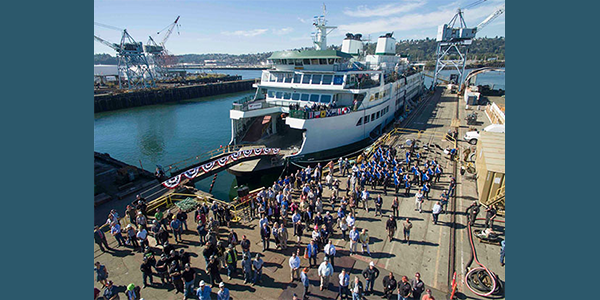Deliveries will begin in 2028 if all goes well — delays and escalating costs have bedeviled the procurement process until now.
||| FROM THE SALISH CURRENT |||
Washington State Ferries on Thursday published an invitation to bid on building five new hybrid-electric ferries, an overdue achievement that promises to eventually bring more reliability to cross-Sound ferry service.
It’s the first time in more than 50 years that the state will accept bids from shipyards nationwide to construct its vessels. Going out to bid on this contract also represents a major step toward electrification of the WSF fleet. But it’s been choppy getting to this point with a years-long delay and rising costs. And the difficulties procuring the new boats have gubernatorial candidates in both parties suggesting it could make more sense to stick with diesel power in the near term.
“This is a great milestone for Washington State Ferries as well as the national shipbuilding industry that has shown strong interest in this program,” said Matt von Ruden, the ferry system’s electrification program manager. “These new vessels are urgently needed as WSF works to restore full service and reduce our environmental impacts.”
For frustrated riders, dealing with delays and cancellations, relief for the ferry system’s boat shortage can’t come soon enough.
WSF has long stated that it needs 26 ferries to provide reliable service on every route, with allowances for maintenance tie-ups and a vessel in reserve.
Entering this summer’s busy season, the beleaguered ferry system has 21 car ferries in its fleet, of which 15 are presently in service on a reduced schedule. Five aging boats are undergoing maintenance or breakdown repairs. Last but not least, the Wenatchee is in drydock in Seattle for conversion to hybrid-electric propulsion. The Wenatchee will be WSF’s first plug-in ferry when it re-launches sometime in the fall.
Bids from shipbuilders on the brand new hybrid ferries will be due in January and the contract awarded in February 2025. WSF declared a preference to split the contract between two low bidders so that two shipyards could go to work simultaneously to deliver new boats faster.
“Under this approach, WSF could achieve delivery of two vessels in 2028, two in 2029, and the final one in 2030 (subject to final bid prices and available funding). These ferries will serve the Clinton/Mukilteo and Seattle/Bremerton routes,” WSF spokesperson Suanne Pelley said in an email Thursday.
‘Responsibility to reduce our emissions’
The bid request published by WSF included the high-level design for a plug-in ferry capable of carrying up to 160 cars and 1,500 passengers. Drawings showed boats that resemble a slightly elongated version of the diesel-powered Olympic class ferries delivered between 2014 and 2018. The latest design has just one passenger deck stacked on top of the two auto decks though. The center of the ship’s hold will be packed with racks of water-cooled rechargeable batteries so the ferry can sail fully on electric power most of the time. The engine room will also feature twin diesel generators as a backup source of propulsion power.
Using green electricity to charge, the nation’s largest ferry system may achieve a 76% reduction in fuel consumption and emissions when it fully transitions its fleet to hybrid-electric vessels, said von Ruden.
“We have a unique responsibility to reduce our emissions,” von Ruden said during a webinar for potential bidders. “We are the largest contributor of greenhouse gas emissions in state government. Before COVID, we were burning 19 million gallons of diesel fuel per year.”
Over the last two legislative sessions, state budget writers set aside close to $1.3 billion to pay for new ferries over the next six to eight years. That works out to roughly $250 million per new ferry.
If bids come in high, ferry system managers may end up having to pick a poison. They might only be able to acquire four new boats in this round. Or they could plead to the Legislature for even more money. Or try to pare back the design to reduce costs.
The four leading candidates to replace outgoing Gov. Jay Inslee have all expressed willingness to revert to diesel power for at least the first couple of new ferries to get them built faster and cheaper.
“If that means that we have to extend our reliance on diesel-powered ferries in the short-term, then we should do that while taking advantage of new, cleaner, hybrid ferries downstream,” wrote GOP frontrunner Dave Reichert in an open letter that blasted Inslee for what Reichert called a “mismanaged nightmare” on the governor’s watch.
WSF and Inslee contend that going back to conventional diesel propulsion would only delay matters even more because the bid documents and ferry design would have to be reworked.
Another wrinkle is that legislators made nearly $200 million of the new boat and terminal electrification spending contingent on voter rejection of a ballot measure this November. The initiative measure, I-2117, seeks to repeal the state’s cap-and-trade program. The ferry money is among a raft of spending that is hanging in the balance depending on whether or not voters want to sustain the state’s carbon pollution permit auctions that bring in the dough.
**If you are reading theOrcasonian for free, thank your fellow islanders. If you would like to support theOrcasonian CLICK HERE to set your modestly-priced, voluntary subscription. Otherwise, no worries; we’re happy to share with you.**








